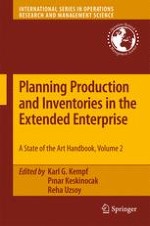2011 | OriginalPaper | Buchkapitel
2. Production Planning and Scheduling: Interaction and Coordination
verfasst von : Yiwei Cai, Erhan Kutanoglu, John Hasenbein
Erschienen in: Planning Production and Inventories in the Extended Enterprise
Verlag: Springer New York
Aktivieren Sie unsere intelligente Suche, um passende Fachinhalte oder Patente zu finden.
Wählen Sie Textabschnitte aus um mit Künstlicher Intelligenz passenden Patente zu finden. powered by
Markieren Sie Textabschnitte, um KI-gestützt weitere passende Inhalte zu finden. powered by
